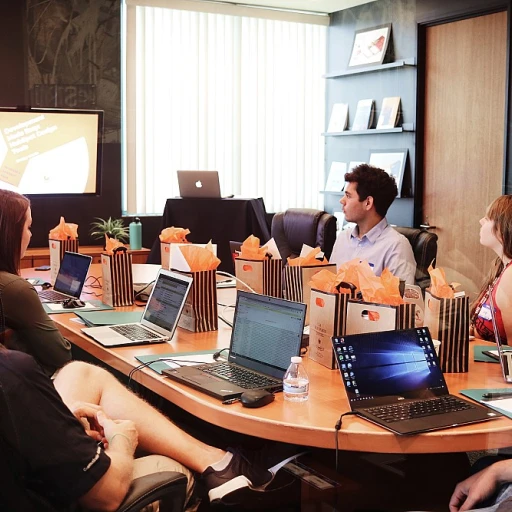
Understanding Leadership Dynamics
Exploring the Dynamics of Leadership
Leadership dynamics within a company are like the intricate gears of a well-oiled machine. Understanding these dynamics is crucial for any executive looking to steer their organization towards success. The top-down and bottom-up approaches represent two distinctive methods that can drastically influence a company's direction and its operational effectiveness.
The top-down approach is often characterized by centralized decision making, where senior management outlines strategic goals and directives for employees at all levels to follow. This method can bring clarity and uniformity to planning, as the leadership sets a clear vision and course for the company. However, it risks alienating team members if their input is not sufficiently valued, potentially impacting morale and job satisfaction.
Conversely, the bottom-up approach encourages a more inclusive and participatory decision-making process, where employees at various levels contribute to planning and management goals. By tapping into the diverse experiences and ideas of team members, companies can foster innovation and agility. This inclusive method facilitates a deeper connection between departments and teams, which could be particularly beneficial in markets that are rapidly changing or where the company aims to explore new areas and project management strategies.
For a C-suite executive, navigating these leadership methods involves weighing the strategic implications and potential impact on team dynamics and company culture. Recognizing when to exert control and when to empower employees can be instrumental in achieving organizational success.
Indeed, finding the balance between these approaches isn't just about choosing one over the other, but rather integrating aspects of both to suit the company's unique goals and market needs. Executives should assess data, including market size and occupational forecasts, to make informed decisions that align with best practices and desired outcomes.
To delve deeper into aligning these leadership strategies with long-term objectives, visit strategic alignment for C-suite success for expert insights and guidance.
Strategic Implications for the C-Suite
Strategic Implications for Effective Leadership
In today’s competitive landscape, strategic decision making is critical for C-Suite leaders to guide their companies towards success. Determining whether the top-down or bottom-up leadership approach suits your organization can significantly influence your strategic direction, including finance and forecasting processes.- Top-Down Approach: This method centralizes decision making at the highest level, allowing for streamlined execution of project management and planning. A top-down approach effectively aligns departments and teams to company goals, providing clear directives for teams to follow.
- Bottom-Up Approach: By leveraging the insights of all team members, this approach promotes a more inclusive atmosphere. While fostering collaboration, the bottom-up method encourages innovation and participation from employees at various levels, impacting occupational therapy and project execution positively.
Balancing Control and Empowerment
Weighing Authority and Delegation in Decision-Making
Navigating the spectrum between control and empowerment is a central aspect of leadership strategies. The adoption of a top-down approach typically centers around centralized decision-making, ensuring swift implementation of strategic goals and alignment across departments. For CEOs, this method can be invaluable in scenarios demanding urgent action or where a cohesive company vision is paramount. Conversely, a bottom-up approach emphasizes empowering employees by harnessing their insights and creative problem-solving skills. This not only fosters innovation but also strengthens employee engagement and loyalty, as team members feel more involved in company success. Engaging in bottom down forecasting can dynamically adjust strategies based on ground-level feedback, thereby enhancing strategic agility. However, finding the right balance hinges upon understanding both the project's nature and the organizational culture. In project management, for instance, blending these approaches can facilitate a more nuanced strategy by combining control with empowerment. Effective cls fill in strategic initiatives empowers teams while retaining overarching guidance from the leadership. Moreover, integrating both top down and bottom methods can optimize occupational therapy processes and team dynamics. This hybridization creates a resilient structure that adapts to evolving cls and market expectations. By judiciously blending approaches, companies can ensure they leverage the best of both worlds, fostering a more responsive and adaptable leadership framework. For CEOs looking to strike this balance, understanding strategic alignment within the C-suite is crucial. It acts as a cornerstone, guiding the distribution of authority and cultivating an environment where strategic goals harmonize with the collective ambitions of team members. This empowerment-driven model promises not only effective project outcomes but a robust and agile organizational culture.Case Studies in Leadership Approaches
Real-World Applications of Leadership Styles
Exploring real-world examples of leadership approaches provides valuable insights into how different methods can impact a company's success. By examining both top-down and bottom-up strategies, we can better understand their effects on project management, decision-making, and overall company culture.
Top-Down Leadership in Action
In a top-down approach, decisions are made by the higher levels of management and then communicated down to employees. This method can be particularly effective in industries where quick decision-making is crucial, such as finance or large-scale manufacturing. For instance, a company operating in a volatile market might rely on top-down forecasting to swiftly adapt to market changes. This approach ensures that strategic goals are aligned across departments and teams, maintaining a cohesive direction.
Bottom-Up Leadership: Empowering Employees
Conversely, a bottom-up approach emphasizes employee involvement in the decision-making process. This method can foster innovation and increase job satisfaction, as team members feel more valued and engaged. In the tech industry, for example, companies often use bottom-up planning to harness the creativity and expertise of their employees. By encouraging input from various levels, organizations can develop more comprehensive and effective strategies.
Hybrid Approaches: The Best of Both Worlds
Many successful companies adopt a hybrid approach, blending elements of both top-down and bottom-up leadership. This allows them to maintain control over strategic objectives while empowering employees to contribute to the company's success. By balancing control and empowerment, organizations can create a dynamic work environment that adapts to changing circumstances and leverages the strengths of both approaches.
Understanding these case studies highlights the importance of flexibility in leadership. As market conditions and company needs evolve, so too must the strategies employed by the C-suite. By learning from these examples, leaders can craft a tailored approach that aligns with their organization's unique goals and challenges.
Adapting to Change: Flexibility in Leadership
Embracing Adaptability in Evolving Leadership Landscapes
In the ever-changing market landscape, flexibility in leadership plays a crucial role in maintaining an organization's competitive edge. As businesses navigate through strategic plans and goals, leaders must be adept at adjusting strategies to align with changing conditions and stakeholder expectations. One approach is to blend elements from both top-down and bottom-up methods. This requires a keen understanding of the company's strategic objectives and an awareness of how each method affects team dynamics. Here’s how flexibility can be infused into leadership:- Employee Empowerment: Encouraging employees to participate in decision-making contributes to a culture of innovation and adaptability. When team members feel valued, especially at the operational level, they are more likely to contribute positively to project outcomes.
- Data-Driven Insights: Embracing a data-oriented strategy allows leaders to respond swiftly to changes in the market. By utilizing down forecasting and bottom forecasting, companies can anticipate shifts and adjust their approach without significant disruption.
- Dynamic Project Management: Effective management requires both clear direction from the top and agile input from bottom layers. By employing a hybrid approach, leaders can foster a robust interplay between strategic planning and ground-level execution, aiding swift adaptation in uncertain markets.
- Inclusive Communication: Open channels of communication across departmental teams enhance the ability to pivot strategies as needed. By valuing feedback from all organizational levels, from finance to occupational therapy, leaders can foster a climate that thrives on adapted approaches.
Crafting a Hybrid Approach
Crafting a Balanced Path Forward
In the ever-evolving landscape of corporate leadership, navigating between top-down and bottom-up approaches successfully requires a blend of strategy, adaptability, and foresight. C-suite leaders face the task of crafting a methodology that aligns with their company's goals while empowering all levels of the organization.- Integrating Diverse Approaches: To create a hybrid path, it is essential to integrate the control found in top-down approaches with the flexibility of bottom-up methods. This ensures that leadership directives align with market trends while also considering insights from team members at various levels. By embracing occupational therapy techniques that prioritize feedback, leaders can ensure their decisions are informed by real-time data and team insights.
- Project Management and Decision Making: Hybrid leadership encourages effective project management and strategic planning. By incorporating both top-level decision-making with grassroots-level insights, leaders can orchestrate a more engaged workforce, enhancing both planning accuracy and project success rates.
- Foster Collaboration Across Teams: Leveraging departments and teams as sources of strategic input propels the organization toward sustained success. Encouraging employees to participate in bottom forecasting and planning sessions cultivates a bottom-top synergy that enhances overall company performance.
- Adapting Methods for Greater Impact: Leaders must remain open to adapting their methods to suit the company’s evolving needs. This involves maintaining a flexible approach that accommodates changing market sizes and conditions without diluting strategic intent. Empowering departments to perform bottom-up planning allows for adjustments that are responsive to real-world changes.














